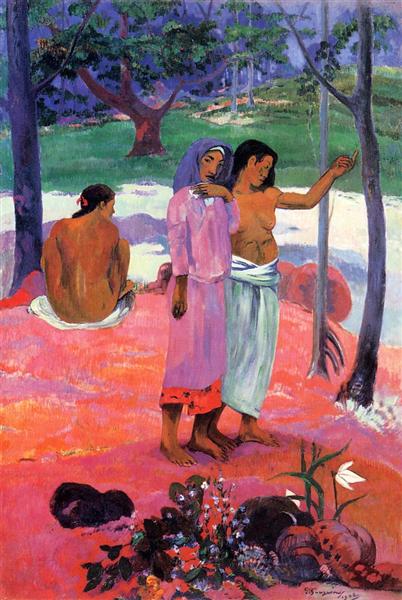Описание
В «Звоке», нарисованном Полом Гогеном в 1902 году, раскрывается одна из самых отличительных характеристик его работы: слияние примитивной эстетики с глубоким и вызывающим воспоминанием символизм. Эта картина представляет собой исследование жизни на острове Таити, где Гогена искал убежище и подлинность от западного мира. Влияние таитянского пейзажа и культуры ощутимо в этой работе, которая воплощает как желание нового начала, так и желание многолетнего значения.
Композиция «вызова» значительна; Глаз зрителя направляется к дну через серию форм, которые, хотя и стилизованы, вызывают ощущение глубины и трехмерности. На переднем плане наблюдается женская фигура, которая, кажется, поглощается созерцанием. Его осанка загадочная и безмятежная, предполагая интимную связь с миром природы, который его окружает. Фигура помещается в яркую среду, где обильная растительность, представленная богатыми и насыщенными цветами, завершает главного героя, почти как если бы Природа претендовала на свое существование. Преобладают зеленые и желтые тона, подчеркивая экзотическую красоту таитянского пейзажа.
Использование цвета в «Вызове» является одним из наиболее заметных аспектов работы. Гоген, известный своей смелой палитрой, решает использовать дополнительные цвета, чтобы подчеркнуть эмоции сцены. Цвета не просто описательные, но выражают настроение и чувства. Выбор ясного и безмятежного синего на фоне контрастирует с ужасными коричневыми коричнами женщины, отмечая четкое разделение между человеком и окружающей средой, в то время как яркий зеленый цвет растительности предполагает почти ощутимое жизнеспособность.
Гогена часто ассоциируется с символикой, и в «Звоке» проявляется в расположении элементов и их отношениях с центральной фигурой. Фигура, которая привлекает наше внимание, хотя она одинока, кажется, является представителем духовного мира, который предлагает самоанализ. То, как он находится в центре холста, почти благоговейно, предлагает звонок, связь с чем -то большим, чем она. Этот аспект подкрепляется тем, как природные элементы, кажется, реагируют на их присутствие, создавая почти мистическую атмосферу.
Работа также можно рассматривать как отражение собственной борьбы Гогена с его личности и его поиска смысла. В свои годы в Таити Гоген работал, чтобы освободиться от художественных соглашений европейского искусства, ищет вдохновения в искусстве коренных народов и более сенсорной и прямых опытов. «Так -названные» инкапсулирует эти желания, где художник пытается передать дух места и его народа через визуальный язык, который продолжает резонировать с современными зрителями.
Хотя «призыв» может быть не так широко признан, как другие произведения Гогена, он представляет собой фундаментальную нить в повествовании о своей художественной эволюции. Она пропитана светом и сущностью Таити, подчеркивая подход к красоте мира природы и человеческому опыту, который характерен для ее произведений этого периода. Таким образом, эта картина вписана в более широком контексте в пост -импрессионистском движении, где поиск эмоциональной истины и личного выражения превышает простое визуальное представление.
Таким образом, «Призыв» является свидетельством способности Гогена переводить свой опыт художественным способом, который, хотя и тесно личный, резонирует с универсальным ощущением призыва к связи и духовности. Работа остается неотъемлемой точкой отсчета в истории искусства, напоминающей нам о силе цвета, формы и повествования в его чистом виде.
KUADROS ©, знаменитая краска на вашей стене.
Ручные картины маслом, с качеством профессиональных художников и отличительной печати KUADROS ©.
Служба воспроизведения с изображениями с гарантией удовлетворения. Если вы не полностью удовлетворены копией вашей картины, мы возвращаем ваши деньги на 100%.

